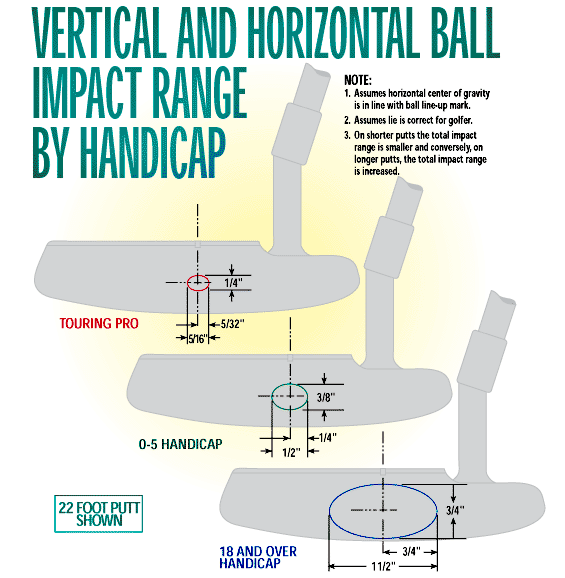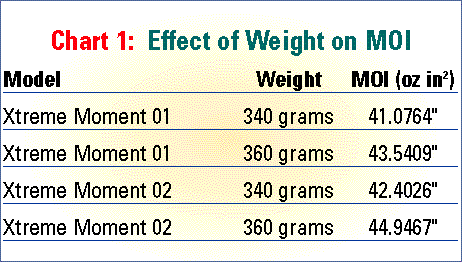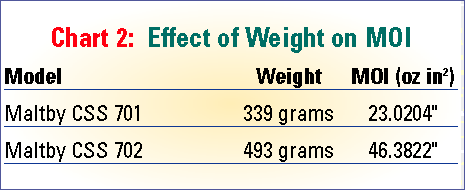Putter Moment of Inertia
by: Britt Lindsey - VP of Technical Services
Recently, I did a seminar at the PCS (Professional Clubmakers Society) Expo on the Maltby Playability Factor and on the effect of Moment of Inertia (MOI) in putters. The MOI information presented explained the relationship between the MOI of Low and High Moment putter heads and the effective sweet spot in putters. Also illustrated was the effect of off-center hits with low MOI putters vs. high MOI putters. After the presentation, a seasoned clubmaker came up to me and said:
"Based on the information presented, why would anyone want to use anything but the highest MOI putter available?"
My response was "I don't know." The fact is, the higher the MOI in a putter head, the better chance a player has to making putts. Compared with look, alignment features and feel, MOI ranks at the top of the list. So, if making putts is something you or your customers want to do more of, knowing which putter gives you the best chance of doing just that is vitally important.
The concept of Moment of Inertia in a putter is really very simple. Moment of Inertia itself can be defined as a measurement of an object's resistance to twisting. The higher the MOI of an object, the more resistant (or harder) it is to get to rotate about its center. The lower the MOI of an object, the less resistant (or easier) it is to get in motion. The art of putting requires us to strike the golf ball with a particular type of mass (putter head), and we want that mass to transfer the energy directly to the object we are trying to target (in this case, a golf ball). Because we cannot hit the object perfectly every time (not very often at all really), energy is lost, along with a distance and directional control. More often than not, the golfer will strike the putt off-center. The putter head will twist, which not only causes loss of the energy going forward, but will also cause directional problems as well. The loss of distance and directional control is what causes us to be unsuccessful on the green.

Diagram 1 illustrates the vertical and horizontal ball impact range we have observed by handicap. It is important to note that although ranking by handicap gives us a starting point, these guidelines will not hold true for all golfers. Handicap can tell us what kind of scores a particular golfer shoots, but it does not tell us definitively the kind of ball striker they are. The majority of players, however, fall into these ranges. The diagram assumes the center of gravity is in the center of the face, but that is not always true. In fact, putters that have hosels usually have the center of gravity slightly toward the hosel. Putters without hosels usually have the center of gravity more in the center of the face. Most experienced players will instincively find where the putt feels the most solid, that being on the center of gravity.
In the diagram, the ovals on the face show the range of face impact on a 22- foot putt. The Tour pros impact point only varies by 1/8" on each side of the center while the 0-5 handicap player's impact range is double that. The 18 and over handicap player shows a much wider range of impact points. This alone causes inconsistency, but add in the fact that many putters used today have a relatively low moment of inertia, and the effect is magnified. The 3/4" variance on each side of the center point in the diagram is probably conservative, and many players will have wider ranges. Still, even with that conservative estimate, 3/4" on each side represents a 11/2" span across the front of the putter face! For all golfers, the longer the putt, the wider the range of contact point. The longer the putt, the worse it gets.

Diagram 2 illustrates how dramatic the effect of an off-center hit is. Using the Maltby Design Studio robots and our MOI test putter, the results are very clear. The high MOI putter (43.3337 oz-in2) shown at the top of the diagram rolled a 22-foot putt struck 3/4" off-center closer to the intended line and closer to the desired distance on both the heel and the toe impacts. In fact, both off-center hits still had a chance of going in or would result in an easy tap in if they didn't fall.
In contrast, the lower moment putter (29.8646 oz-in2) fell far short of the desired distance and did not maintain the intended line! On the toe hit with the low moment putter, the ball stopped 52" short of the cup and right of the intended line! The heel hit on the low moment putter stopped 32" short of the cup and left of the intended line. This difference is that the shaft stabilizes the heel hit slightly more, but not enough to make it acceptable. And this is with a robot aimed perfectly at the cup and striking the ball at the same speed every time.
It is important to note that our low moment test putter at 29.8646 oz-in2 is not as low of a moment as many other popular putters. However, it is significantly less than the high moment test putter, which is at the upper limit so far for a 350-gram head weight putter. To put this into perspective, an original center shafted bullseye putter that many of us used in years past has an MOI of 13.1753 oz-in2. An original Ping Anser Scottsdale, 15.9859 oz-in2. The original Zebra by Ram (one of my former favorites), 17.5832 oz-in2. Based on our research, the lower the moment, the worse the results.

The weight of the putter head also plays a role. Chart 1 shows that a 20-gram difference in weight of a putter with identical dimensional characteristics, like our Xtreme High Moment 01 model, increases the MOI by approximately 5.6%. Chart 2 shows that if the head gets both heavier and bigger in size, the difference can be even more dramatic. Although these Maltby CSS putters are the same design, the 702 is heavier AND larger in its dimensions. This produces an MOI that is more than double that of the CSS 701. The 493-gram 702 is designed for use as a long putter and that is why the weight is significantly higher.

Another point to make with regards to the MOI rating in putters deals with the design itself. For the first time in a many years, styles of putters are becoming more extreme and the parameters of performance are being stretched. However, just because a putter looks unconventional (or just plain weird) does not automatically make it a High MOI putter that will perform better than all of the more normal designs we have come to be comfortable with. There has to be a method to the madness in the design of a putter.
Design is a key feature on how high the MOI of a putter can be. The point to make here is that although many of the new, less conventional looking designs do claim to have a higher moment of inertia, don't be confused into thinking that just because a putter is different in shape that it has a higher MOI. You can have a big ugly shape and still have a low MOI. We've tested models that make MOI claims that just don't pan out!.
If all players hit every putt in the center of the face all the time on every type of putter, MOI would not matter. However, we know that does not happen. While it is true the tour professionals might benefit the least, there is still benefit (ask Ed Sneed). If the goal is to give a player a putter that gives them the best chance to make a putt from any distance, the highest Moment of Inertia putter possible IS what all players should use.
